Well, sort of. On the last CSC Baja run back in March of this year, as the guys were signing up to register for the ride I had one fellow send in an email with the name “Buffalo.”
“What’s your real name?” I asked.
“Buffalo.”
Well, it turns out that “Buffalo” really was his name. But wait, there’s more. Buffalo is a world-famous artist. We can’t make this stuff up, folks. Check out this video and you’ll see…
Anyway, the first guy who signed up for the CSC ride was Tim. Buffalo is Tim’s cousin, and both gentlemen rode with us in Baja on the CSC ride. When they returned, Tim’s daughter bought the same motorcycle Buffalo and Tim rode in Baja: A CSC RX3. And then, not having had enough of a good thing, Buffalo, Tim, and Tim’s daughter rolled south in Baja again. Wowee!
I asked this intrepid trio if they would consider sending a story and a few photos to us, and they did. Here’s the story…
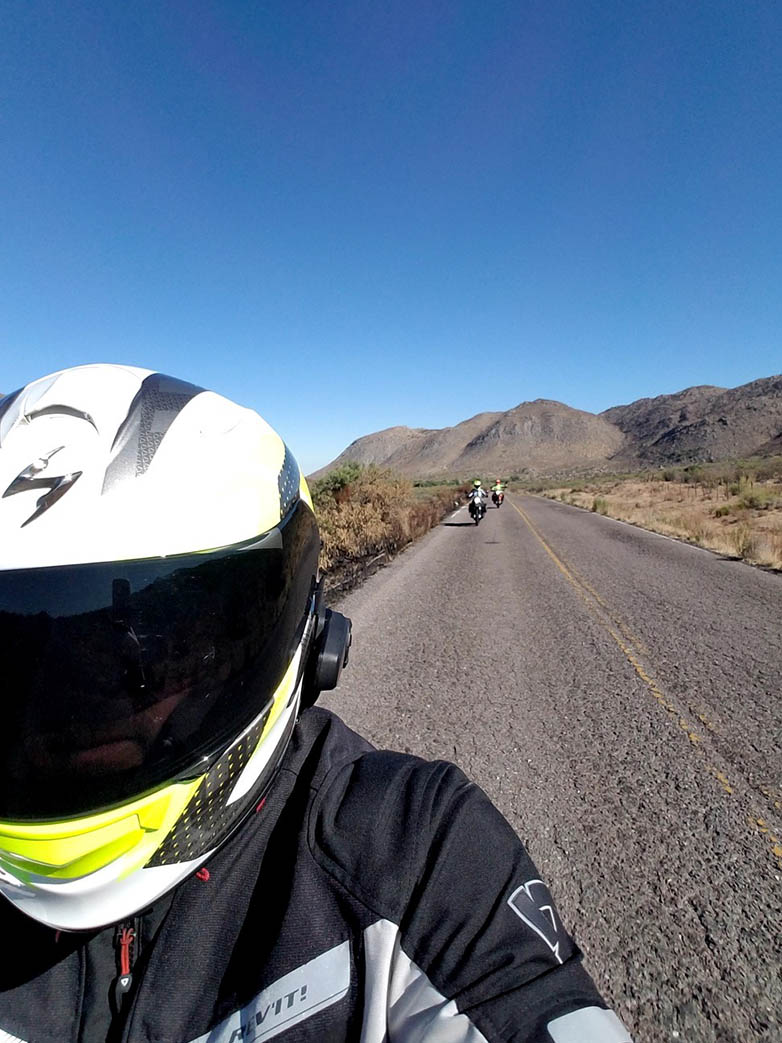 Two cousins, and one’s 18 year old daughter, ride their CSC RX3 250cc adventure bikes on a 5 day adventure in Baja, Mexico.
Two cousins, and one’s 18 year old daughter, ride their CSC RX3 250cc adventure bikes on a 5 day adventure in Baja, Mexico.
Day 1 – We rode from Burbank through San Diego, crossed the border at San Isidro, and took the cuota (toll road) along the coast to Ensenada. We rode a little bit farther from the tourist zone than usual to find our Air B&B for the night. We were almost there when a detour was required to get around a barrier in the middle of the cross street. Instead, we embraced Mexico-style and found a section of broken curb that allowed us to get some air as we moto-crossed our way to the other side. We took a perilous walk down an open-hole/rebar minefield sidewalk to Guadalajara Birrieria for some tasty stewed goat meat tacos and margaritas with locals enjoying live mariachi music.
Day 2 – We rode a really great winding mountain road southwest out of Ensenada on Hwy 3 to a high plateau and the little town of Lázaro Cárdenas. We filled up with gas and met a couple of retirees on quads who, after taking a minute to find their hearing aids, showed us lots of paper maps and advised us to change our planned route south past Mike’s Sky Rancho due to the road being in very poor shape. Instead we took 42 epic off-road miles west towards San Vicente. The dirt road was alternately sandy, hard packed, rocky, and ridged, along mountains and valleys, curves and slopes. Several times a nice section of hard pack tempted us to pick up the speed before patches of deep sand would suddenly grab our front tires, throwing the bikes unexpectedly. Each of us took at least one spill, but we were wearing full ATGATT so we only had some bruises to show for it, though our trusty RX3s required some roadside bending and bungee strapping. It was awesome. We popped out on Hwy 1 some hours later and headed south for some roadside fish tacos before finding our funky partially-finished concrete and rebar hotel resort (La Cueva del Pirata) on the beach at the end of a bit more dirt road in Camalu.
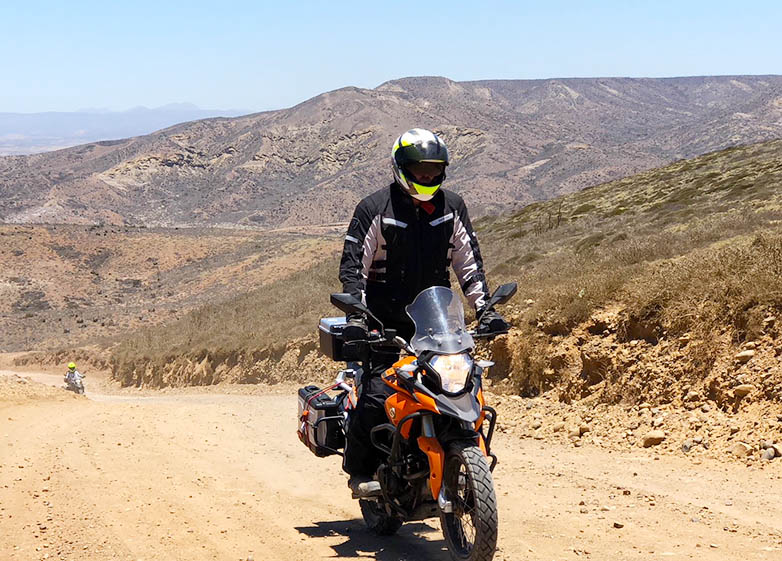
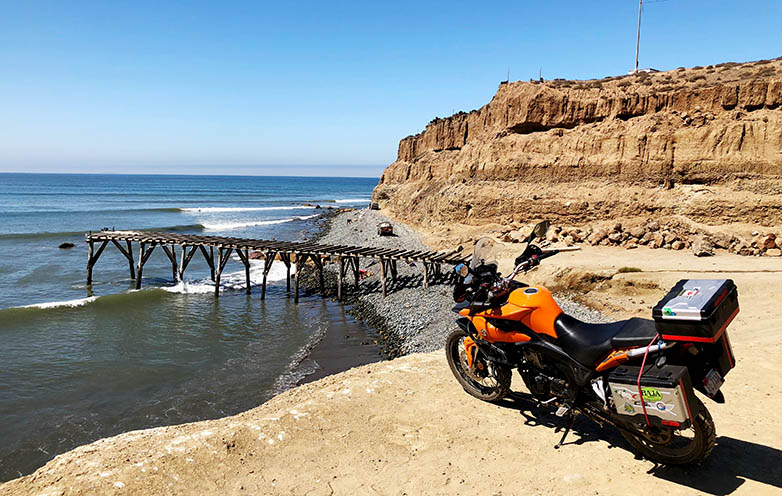 Day 3 – We rode south along a beautiful coastal section of Hwy 1 before a short but fun mountain pass, a military checkpoint, and then into El Rosario, where we decided to take the 16km (10 mile) dirt/gravel road out to Punta Baja, which is just a little fishing village with a dozen or so buildings. We asked some fisherman and found a little collection of picnic tables on a dirt floor under a building, where a lovely woman named Betty made us some abalone soup and fish tacos, and we met a lawyer from Texas with a dual sport and a surf board that was staying in one of the rooms upstairs and still hadn’t figured out how to work the toilets. The ride back to the highway was fast and fun, now that we knew the road and where the dogs would make chase. Next we rode up up up and into the desert of giant boulders and giant Saguaro cactus on our way to our turn-around point of Cataviña, where we stayed at the nice but pricey Hotel Mission Cataviña, with its delicious Micheladas and iffy electricity.
Day 3 – We rode south along a beautiful coastal section of Hwy 1 before a short but fun mountain pass, a military checkpoint, and then into El Rosario, where we decided to take the 16km (10 mile) dirt/gravel road out to Punta Baja, which is just a little fishing village with a dozen or so buildings. We asked some fisherman and found a little collection of picnic tables on a dirt floor under a building, where a lovely woman named Betty made us some abalone soup and fish tacos, and we met a lawyer from Texas with a dual sport and a surf board that was staying in one of the rooms upstairs and still hadn’t figured out how to work the toilets. The ride back to the highway was fast and fun, now that we knew the road and where the dogs would make chase. Next we rode up up up and into the desert of giant boulders and giant Saguaro cactus on our way to our turn-around point of Cataviña, where we stayed at the nice but pricey Hotel Mission Cataviña, with its delicious Micheladas and iffy electricity.
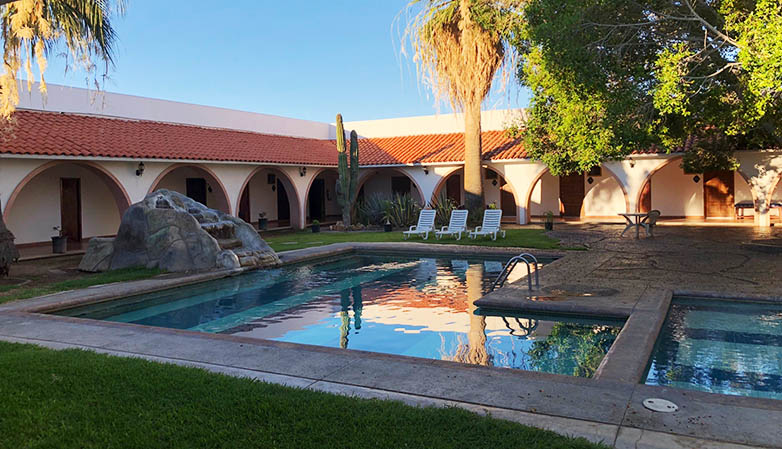 Day 4 – Since there are no gas stations, we began our ride back northwest by buying three plastic jugs of gasoline from some guys on the side of the road with our last twenty dollars cash, and had a lovely early morning ride through the desert before the day got too hot. Coming back to El Rosario, we had a fantastic mid-morning breakfast at the famous Mama Espinosa’s (cash only, try the ABD Supermarket), and headed north again. Back in Ensenada we cranked the Mexico-style adventure to eleven and got matching tattoos before having some tasty street tacos and cervezas.
Day 4 – Since there are no gas stations, we began our ride back northwest by buying three plastic jugs of gasoline from some guys on the side of the road with our last twenty dollars cash, and had a lovely early morning ride through the desert before the day got too hot. Coming back to El Rosario, we had a fantastic mid-morning breakfast at the famous Mama Espinosa’s (cash only, try the ABD Supermarket), and headed north again. Back in Ensenada we cranked the Mexico-style adventure to eleven and got matching tattoos before having some tasty street tacos and cervezas.
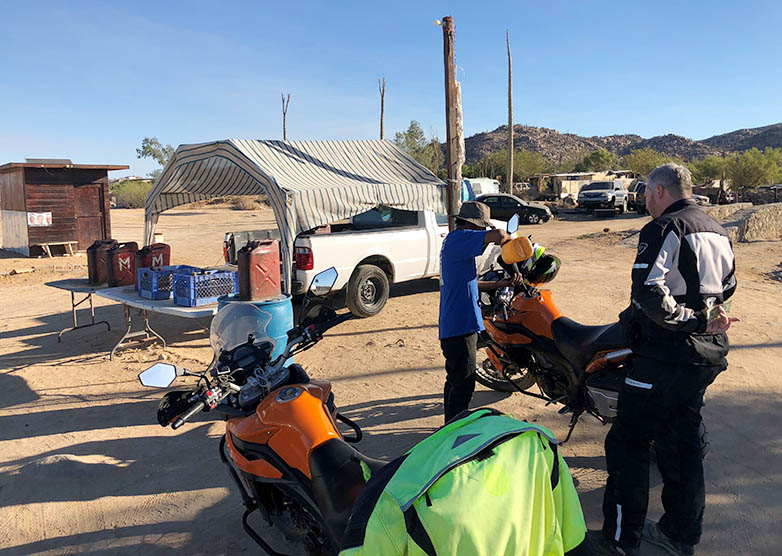
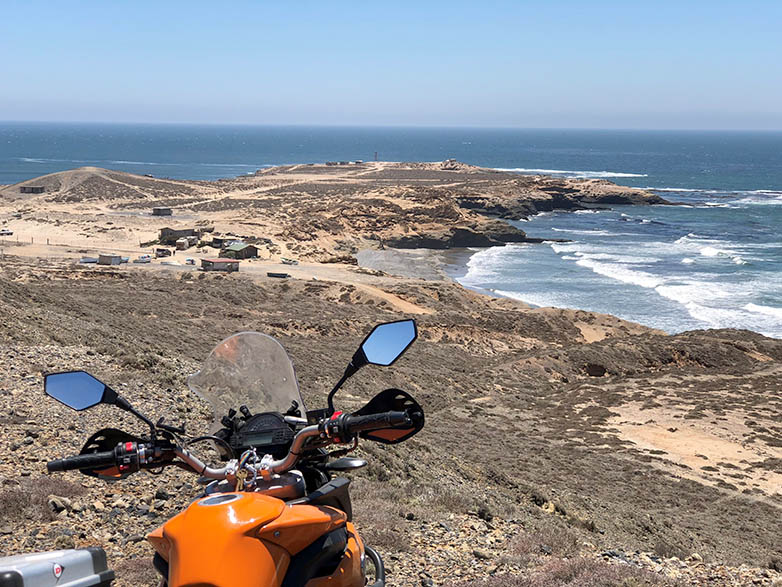
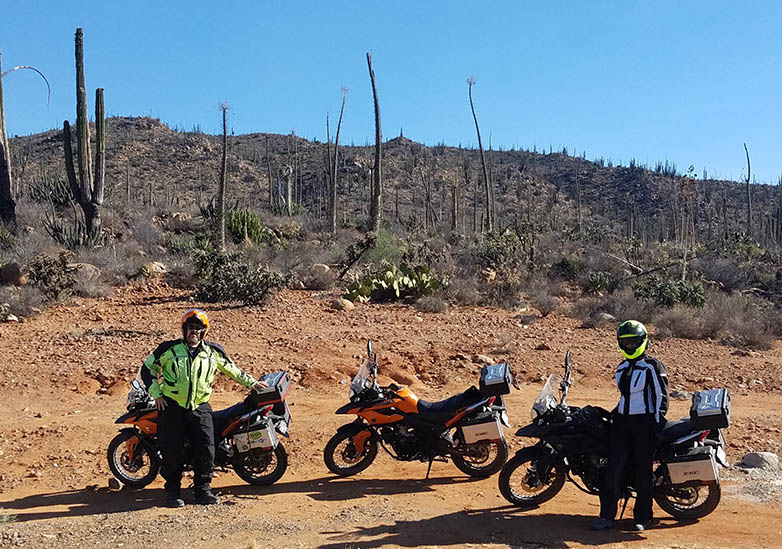 Day 5 – Taking Hwy 3 just north of Ensenada, we finally passed a stinky truck likely carrying fish guts and rode the beautiful La Ruta del Vino (wine route) through the Guadalupe Valley and the mountains towards Tecate. We jumped on our last chance for some authentic Mexican street tacos at Tacos el Guero, and then we rode up Presidente Rubio Street and popped out right at a gap in the traffic barriers to meet the front of the line to cross the border. We were waved in by a nice man in a Mexican-plated pickup truck. Total time to cross: about 4 minutes. The hill country ride up Hwy 94 was a pleasant re-acclimation to driving in the U.S., and soon we were splitting lanes on the 15 North back to the LA area.
Day 5 – Taking Hwy 3 just north of Ensenada, we finally passed a stinky truck likely carrying fish guts and rode the beautiful La Ruta del Vino (wine route) through the Guadalupe Valley and the mountains towards Tecate. We jumped on our last chance for some authentic Mexican street tacos at Tacos el Guero, and then we rode up Presidente Rubio Street and popped out right at a gap in the traffic barriers to meet the front of the line to cross the border. We were waved in by a nice man in a Mexican-plated pickup truck. Total time to cross: about 4 minutes. The hill country ride up Hwy 94 was a pleasant re-acclimation to driving in the U.S., and soon we were splitting lanes on the 15 North back to the LA area.
That’s an awesome adventure, guys, and thanks very much for sharing it with us. Great riding and great photos, and we sure appreciate seeing both! Baja is indeed a great place. Matching tattoos? Now there’s an interesting touch to a Baja tale! You’ve got to send us photos of those!

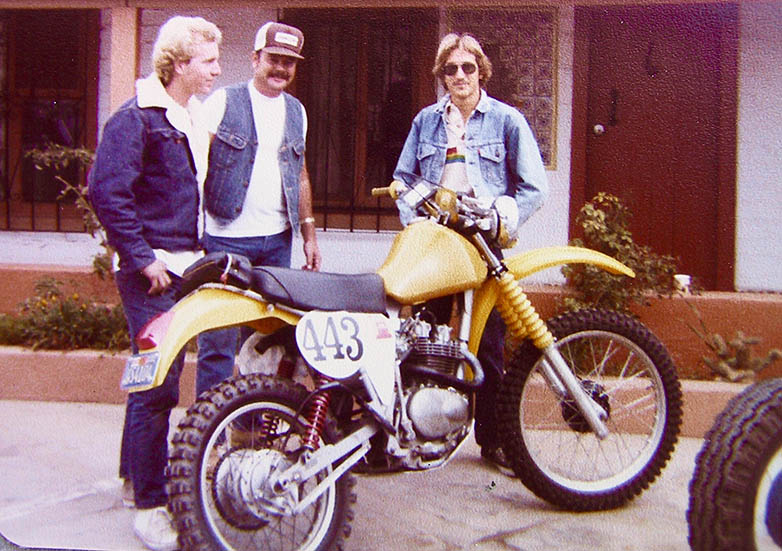
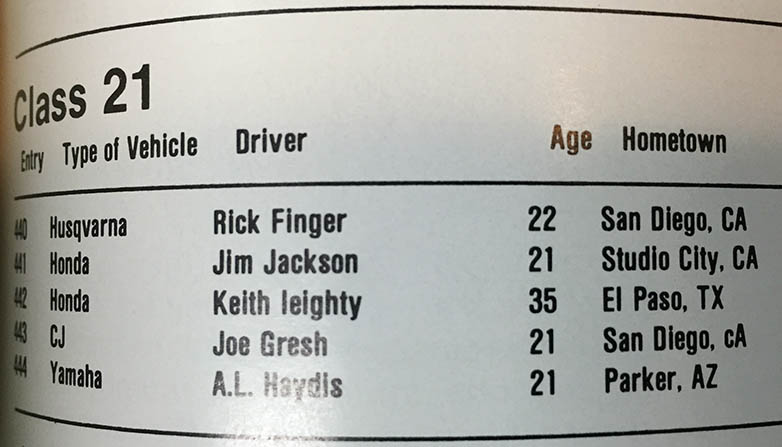



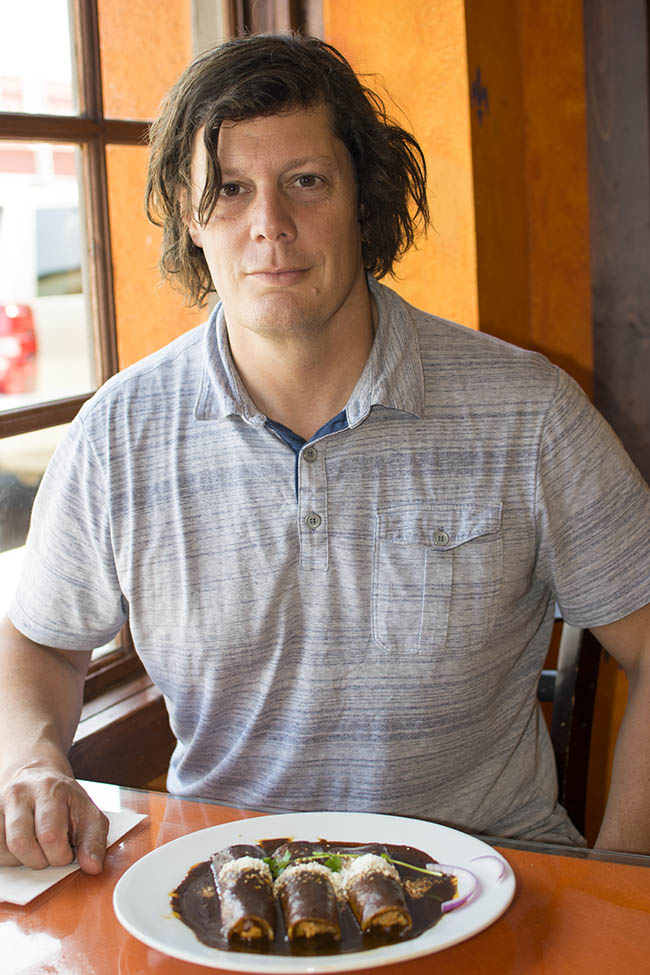
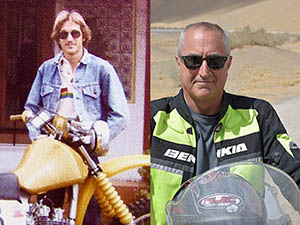
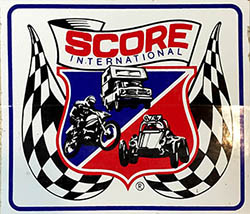 The plan was genius: In 1979 there were only five entrants in the 250cc class. With a historical attrition rate of at least 50%, the Baja desert would do the dirty work. All we had to do was stay together and keep moving. A podium finish was assured. SCORE, the event organizers, made it even easier by allowing a maximum of 41 hours to complete the course. Hell, a 25 mile-per-hour average would do the trick.
The plan was genius: In 1979 there were only five entrants in the 250cc class. With a historical attrition rate of at least 50%, the Baja desert would do the dirty work. All we had to do was stay together and keep moving. A podium finish was assured. SCORE, the event organizers, made it even easier by allowing a maximum of 41 hours to complete the course. Hell, a 25 mile-per-hour average would do the trick.